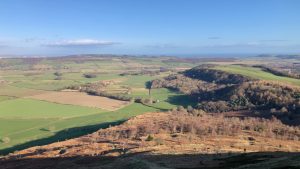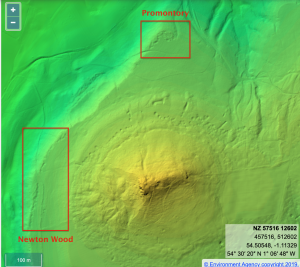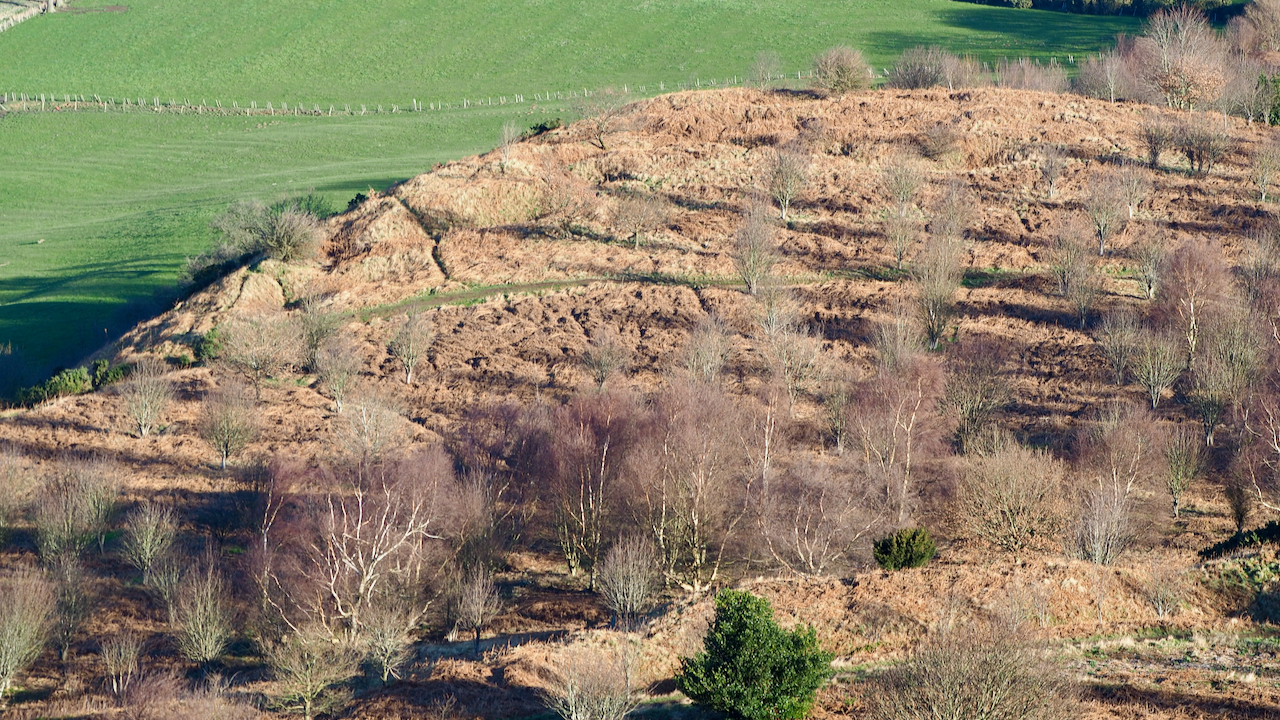My posting of Cockle Scar three days ago reminded of the mysterious pits that align the top of the scar.

I posted about them in 2017 featuring a photo of the southern end of the scar in Newton Wood. They continue almost linearly along the edge finishing in a cluster at a promontory, at the northern end.
Typically the pits are about 15 feet in diameter and 3-6 feet deep and follow approximately the 200 metre contour.
They are fairly continuous although it appears that landslips have occurred in the distant past and the pits survived the slippage and can be seen at the bottom of the slope.
 LIDAR view of Roseberry
LIDAR view of RoseberryIf you look closely on the featured image, the pits can be made out. But they are better viewed through from the air, so I have added a LIDAR view of Roseberry Common.
There are lots of theories as to what the pits were, ranging from a supposed British settlement by Victorian antiquarians to military or defensive or ritual.
Modern thinking discounts all these and also the suggestion that they are the remains of some sort of mineral extraction (apparently the Staithes Sandstone is thinly bedded and not much good for building — certainly it is not quarried — and the seam is considerably below the ironstone and jet seams).
Sir Alfred Pease recounts doing some digging in the pits when he was a lad and finding flints and arrowheads1“Roseberry Topping”. Great Ayton Community Archaeology Project. 2006 ISBN 978-0-9554153-0-2.. Hardly carried out with modern archaeological rigour.
One latest theory is that they were not a settlement as such but temporary shelters or ‘ergs’ used to provide shelter during summer grazing (or at least reused for that purpose). It is suggested that ergs were hollows with some sort of temporary roofing. Ergs have been identified near Commondale, Swainby and Sleddale. The name is derived from the Irish Gaelic word ‘àirigh‘ meaning a sheiling, a word from which Aireyholme, the farm on the other side of Roseberry, derives its name.
In the 10th century, the North-East had an influx of Norse-Irish settlers coming across the Pennines and there are many examples of Irish Gaelic place-names throughout the North-East.
And now I begin to delve into a world of speculation.
The Ordnance Survey has a webpage “The Gaelic origins of place names in Britain“2Ordnance Survey (2019). The Gaelic origins of place names in Britain. [online] OS GetOutside. Available at: https://getoutside.ordnancesurvey.co.uk/guides/the-gaelic-origins-of-place-names-in-britain/#:~:text=of%20a%20hill%2C-,cockle,-Allt%20a%E2%80%99%20Chuaich [Accessed 23 Feb. 2022]..
It lists cuach/cuaich/cuachan as meaning the “hollow of a hill” or “cockle” and cites the following examples: Allt a’ Chuaich which is a stream, and Meall Chuaich, a hill3From my understanding ‘ch’ is pronouced hard in Gaelic..
On seeing the word cockle my mind started racing — Cockle Scar, of course. Here on Roseberry, a scar with pits or hollows.
Does cockle have some other Gaelic/Scottish meaning other than a sea mollusc? I suppose an upturned cockle shell could be a “hollow of a hill”.
Andy, a friend who has a much better knowledge of Gaelic than me, thought that Meall Chuaich is named after the traditional Scottish two handled drinking bowl the ‘quaich‘ (there is no q in Gaelic, so it would have been written cuaich). Presumably an upside down bowl as it’s a hill.
Anyhow: bowl, a hollow of a hill, upturned cockle shell — with a bit of wishful thinking, it seems to fit.
Of course, the big assumption is that 10th-century Irish Gaelic is not too dissimilar to Scottish Gaelic.
But, on the other hand, the 1898 English Dialect Dictionary defines a “cockle” as a ripple on the surface of water, caused by the wind; a wrinkle; or, in West Yorkshire, an imperfection in cloth, or where cloth is uneven or gone into lumps4“The English Dialect Dictionary, Being the Complete Vocabulary of All Dialect Words Still in Use, or Known to Have Been in Use during the Last Two Hundred Years; Founded on the Publications of the English Dialect Society and on a Large Amount of Material Never before Printed”. In six volumes edited by Joseph Wright, 1898. Volume I. Internet Archive, 2014, https://archive.org/details/englishdialectdi01wriguoft. Accessed 10 Apr. 2021..
I guess it follows that pitted ground could be described as ‘cockled‘.
Oh well, perhaps a wasted couple of hours going down rabbit holes. It’s fun though.
- 1“Roseberry Topping”. Great Ayton Community Archaeology Project. 2006 ISBN 978-0-9554153-0-2.
- 2Ordnance Survey (2019). The Gaelic origins of place names in Britain. [online] OS GetOutside. Available at: https://getoutside.ordnancesurvey.co.uk/guides/the-gaelic-origins-of-place-names-in-britain/#:~:text=of%20a%20hill%2C-,cockle,-Allt%20a%E2%80%99%20Chuaich [Accessed 23 Feb. 2022].
- 3From my understanding ‘ch’ is pronouced hard in Gaelic.
- 4“The English Dialect Dictionary, Being the Complete Vocabulary of All Dialect Words Still in Use, or Known to Have Been in Use during the Last Two Hundred Years; Founded on the Publications of the English Dialect Society and on a Large Amount of Material Never before Printed”. In six volumes edited by Joseph Wright, 1898. Volume I. Internet Archive, 2014, https://archive.org/details/englishdialectdi01wriguoft. Accessed 10 Apr. 2021.

Leave a Reply